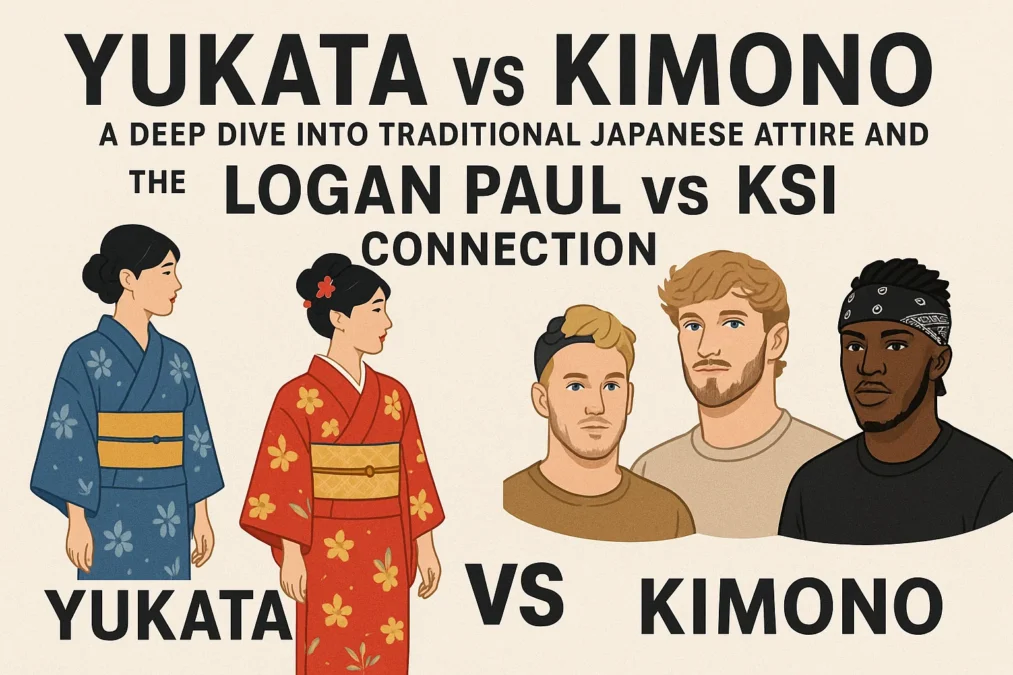When it comes to traditional Japanese clothing, the yukata and kimono are two iconic garments that often spark curiosity and confusion. While they may look similar to the untrained eye, they serve different purposes and carry distinct cultural significance. Interestingly, these traditional outfits have even found their way into pop culture, including the world of YouTube boxing, where personalities like Logan Paul and KSI have donned them. In this article, we’ll explore the differences between yukata and kimono, delve into their cultural roots, and even touch on how they’ve been embraced by modern influencers like Logan Paul and KSI.
Yukata vs Kimono: Understanding the Basics
What is a Yukata?
A yukata is a lightweight, casual garment traditionally worn during the summer months in Japan. Made from cotton or synthetic fabric, it’s designed to be breathable and comfortable, making it perfect for hot weather. Yukatas are often seen at festivals, fireworks displays, and onsen (hot spring) visits. They are typically brightly colored and feature bold patterns, such as floral designs or geometric shapes.
One of the key features of a yukata is its simplicity. Unlike the kimono, which has multiple layers and accessories, the yukata is usually worn with just a single layer and a simple obi (belt). This makes it easier to put on and more accessible for everyday wear.
What is a Kimono?
The kimono, on the other hand, is a more formal and intricate garment. It’s made from silk or other high-quality fabrics and is often worn for special occasions like weddings, tea ceremonies, or coming-of-age celebrations. The kimono is known for its elegant designs, which can include intricate embroidery, hand-painted motifs, and subtle color gradients.
Wearing a kimono is an art form in itself. It involves multiple layers, including an undergarment called a nagajuban, and requires precise folding and tying of the obi. The process can be time-consuming and often requires assistance. This complexity reflects the kimono’s status as a symbol of Japanese tradition and craftsmanship.
Yukata vs Kimono vs Hakama: Adding Another Layer to the Conversation
What is a Hakama?
To further complicate things, let’s introduce the hakama. A hakama is a type of traditional Japanese trousers or skirt-like garment that is worn over a kimono. It’s most commonly associated with martial arts, such as kendo or aikido, but it’s also worn during formal events like graduations or Shinto ceremonies.
The hakama adds an extra layer of formality and structure to an outfit. It’s often seen as a symbol of discipline and respect, which is why it’s frequently worn by practitioners of traditional arts.
Yukata vs Kimono vs Hakama: How Do They Compare?
When comparing yukata, kimono, and hakama, it’s important to consider their purpose and level of formality. The yukata is the most casual of the three, ideal for summer events and relaxed settings. The kimono is more formal and versatile, suitable for a wide range of occasions. The hakama, while not a standalone garment, adds a layer of sophistication and tradition when paired with a kimono.
Each of these garments has its own unique charm and cultural significance. Whether you’re attending a summer festival in a yukata, celebrating a milestone in a kimono, or practicing martial arts in a hakama, you’re participating in a rich tradition that dates back centuries.
Yukata vs Kimono vs Hakama and Haori: The Complete Ensemble
What is a Haori?
The haori is a traditional Japanese jacket that is often worn over a kimono. It’s similar in shape to a kimono but is shorter and more structured. Haoris are typically made from silk and feature elegant designs, making them a popular choice for formal occasions.
One of the key features of a haori is its versatility. It can be worn by both men and women and is often used to add an extra layer of warmth or style to an outfit. Some haoris also feature family crests or intricate patterns, adding a personal touch to the ensemble.
How Do They All Fit Together?
When you combine a kimono, hakama, and haori, you create a complete traditional Japanese outfit that exudes elegance and sophistication. This ensemble is often reserved for the most formal occasions, such as weddings or important ceremonies.
The yukata, on the other hand, is typically worn on its own, without additional layers. This simplicity is part of its appeal, making it a popular choice for casual events and everyday wear.
Logan Paul vs KSI: A Modern Twist on Traditional Fashion
How Did Logan Paul and KSI Bring Yukata and Kimono into the Spotlight?
In recent years, traditional Japanese clothing has found its way into pop culture, thanks in part to influencers like Logan Paul and KSI. Both YouTubers have worn yukatas and kimonos in their videos, introducing these garments to a global audience.
For example, during their highly publicized boxing matches, both Logan Paul and KSI have been seen wearing yukatas and kimonos as part of their promotional content. This has sparked interest in traditional Japanese fashion and helped to demystify these garments for a younger generation.
Tux vs Suit: The Ultimate Style Showdown for the Modern Man
Why Does This Matter?
The fact that Logan Paul and KSI have embraced yukatas and kimonos is significant because it highlights the global appeal of Japanese culture. By wearing these garments, they’re not only paying homage to a rich tradition but also encouraging their fans to learn more about it.
This modern twist on traditional fashion is a reminder that cultural exchange is alive and well. It’s also a testament to the timeless appeal of garments like the yukata and kimono, which continue to captivate people around the world.
The Cultural Significance of Yukata, Kimono, Hakama, and Haori
A Symbol of Japanese Heritage
Each of these garments—yukata, kimono, hakama, and haori—holds a special place in Japanese culture. They are more than just clothing; they are a reflection of Japan’s history, values, and artistic traditions.
For example, the kimono is often seen as a symbol of grace and elegance, while the yukata represents the joy and simplicity of summer. The hakama and haori, on the other hand, are associated with discipline and respect, making them a popular choice for formal occasions.
The Role of Tradition in Modern Japan
While these garments are deeply rooted in tradition, they continue to evolve in modern Japan. Today, you’ll find contemporary designs that blend traditional elements with modern aesthetics, making them accessible to a wider audience.
This balance between tradition and innovation is what makes Japanese fashion so unique. It’s a testament to the enduring appeal of garments like the yukata and kimono, which have stood the test of time and continue to inspire people around the world.
FAQs About Yukata, Kimono, Hakama, and Haori
1. What’s the difference between a yukata and a kimono?
A yukata is a casual, lightweight garment typically worn in the summer, while a kimono is a more formal, intricate outfit suitable for special occasions.
2. Can men wear yukatas and kimonos?
Yes, both men and women can wear yukatas and kimonos. Men’s designs are usually more subdued and feature darker colors.
3. What is a hakama, and when is it worn?
A hakama is a traditional Japanese garment worn over a kimono. It’s often associated with martial arts and formal events.
4. How do you wear a haori?
A haori is worn over a kimono and is typically secured with a tie or clip. It adds an extra layer of warmth and style to the outfit.
5. Why are Logan Paul and KSI associated with yukatas and kimonos?
Both influencers have worn these garments in their videos and promotional content, helping to popularize them among a global audience.
Conclusion
The world of traditional Japanese clothing is rich and diverse, with garments like the yukata, kimono, hakama, and haori each offering their own unique charm. Whether you’re drawn to the simplicity of the yukata or the elegance of the kimono, there’s something for everyone to appreciate.
And with modern influencers like Logan Paul and KSI bringing these garments into the spotlight, it’s clear that their appeal is timeless. So the next time you see a yukata or kimono, take a moment to appreciate the history and craftsmanship behind it.
Quotes:
- “The kimono is not just a garment; it’s a piece of art.” – Unknown
- “Wearing a yukata is like wrapping yourself in the joy of summer.” – Japanese Proverb
Table:
| Garment | Material | Occasion | Formality Level |
|---|---|---|---|
| Yukata | Cotton | Summer festivals | Casual |
| Kimono | Silk | Weddings, ceremonies | Formal |
| Hakama | Various | Martial arts, graduations | Formal |
| Haori | Silk | Formal events | Semi-Formal |
This article provides a comprehensive look at traditional Japanese clothing while tying it to modern pop culture, making it both informative and engaging.



